This is a Leotax Model K, a 35mm rangefinder camera made by Shōwa Kōgaku Seiki K.K. between 1955 and 1958. The Model K was the economy model in the Leotax series, sold with a slower f/3.5 Topcor lens and omitting all slow speeds and the top 1/1000 shutter speed found on other models. All Leotax rangefinder cameras are straightforward copies of the Leica II and III and were sold at a much lower price for people who wanted a Leica-like camera, without the Leica-like prices. Unlike other Japanese Leica copies produced by Canon and eventually Nicca, Leotax cameras do not stray far from Leitz’s original formula.
Film Type: 135 (35mm)
Lens: 5cm f/3.5 Leitz Elmar coated 4-elements (+ others)
Lens Mount: M39 Leica Thread Mount
Focus: 3.5 feet to Infinity
Viewfinder: Separate Viewfinder and Coincident Image Coupled Rangefinder
Shutter: Cloth Focal Plane
Speeds: B, 1/25 – 1/500 seconds
Exposure Meter: None
Battery: None
Flash Mount: Coldshoe and F and X Flash PC Sync
Weight: 593 grams (w/ lens), 480 grams (body only)
Manual (similar model): https://www.cameramanuals.org/pdf_files/leotax_model_f.pdf
How these ratings work |
The Leotax K was the budget model in a lineup of Leotax cameras that were sold as economical alternatives to more expensive Canon and Leica rangefinders. Despite their simpler feature set and lower cost, the Leotax K is a faithful recreation of the Leica’s shooting experience, it has the same ergonomics, and supports the same lenses. This example came to be in terrible condition, yet still worked perfectly, which suggests that these cameras were built well and haven’t suffered the rigors of time any worse than the real thing. | ||||||
| Images | Handling | Features | Viewfinder | Feel & Beauty | History | Age | |
| 2 | 2 | 1 | 1 | 2 | 1 | 30% | |
| Bonus | none | ||||||
| Final Score | 11.7 | ||||||
History
 In the years before and during World War II, the Japanese 35mm camera industry consisted of one model, the Hansa Canon. First released in 1936 with some resemblances to a Leica II, the Hansa Canon was not a true Leica copy. It had a totally different body with angled edges, a large exposure counter on the front face of the camera, a pop up viewfinder, and most significantly, a totally different lens mount.
In the years before and during World War II, the Japanese 35mm camera industry consisted of one model, the Hansa Canon. First released in 1936 with some resemblances to a Leica II, the Hansa Canon was not a true Leica copy. It had a totally different body with angled edges, a large exposure counter on the front face of the camera, a pop up viewfinder, and most significantly, a totally different lens mount.
The Hansa Canon’s lens mount was built by Nippon Kogaku and was similar to the Contax rangefinder mount found on the Zeiss-Ikon Contax. This including the camera’s various other differences made it very difficult to build. It is said that while constructing the lens mount, Nippon Kogaku rejected more mounts than ones that actually made it into cameras because they were so difficult to build correctly.

In 1937, the Empire of Japan became engaged in a military conflict with the Republic of China, in what is now known as the Second Sino-Japanese War. This, combined with increasing tensions in Europe and with the United States, the Japanese military needed a domestic camera that could be used by it’s forces in combat. Although the Hansa Canon sold modestly to private photographers, it was deemed too complex and expensive to make for wartime use, so the Japanese government demanded a new camera that could be built faster, cheaper, and would be compatible with the huge number of lenses that already existed for the screw mount Leica.
One of the most recognizable companies that took up the charge in building a war time Leica copy was Kōgaku Seiki-sha, a small company founded by a former Canon employee named Kumagai Genji. Kumagai formed his new company in 1940, first as a service center for Hansa Canons but later to focus on building military use cameras for the Japanese war effort.
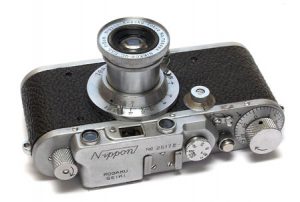
Kōgaku Seiki-sha’s first product was the Nippon rangefinder, a much more faithful copy of the Leica than the Hansa Canon. The Nippon was so close to a Leica III, sharing the same features, body shape, top plate, and lens mount, that externally, other than the name engraved on the top plate, they are difficult to tell apart. The only functional difference was the viewfinder magnification on the Nippon was 1x instead of 1.5x on the Leica III.
Nippon cameras continued to be produced through the end of the World War II, and after the war, would go on sale to the general public, this time using the name Nicca, a name which the company would formally adopt. Nicca cameras became popular alternatives to more expensive German cameras, the most popular of which were sold through the Sears, Roebuck, and Company under the name Tower.
After the war, Canon would wisely drop the complicated lens mount for the Hansa Canon and would use the same 39mm Leica Thread Mount used by Leitz and Nicca, but their cameras were still so different compared to German Leicas, that some collectors don’t even consider them to be Leica copies. For that reason, Nicca rangefinders became known as Japan’s most popular Leica copy, but they weren’t the only one.
In January 1938, a former engineer for Konishiroku named Nakagawa Kenzō, was approached by Yasuo Minagawa, the president of Minagawa Trading, a huge distributor of Japanese cameras at the time, and urged him to start his own camera company. With funding from Minagawa, Nakagawa formed his own company which would eventually be known as G.K. Shōwa Kōgaku.
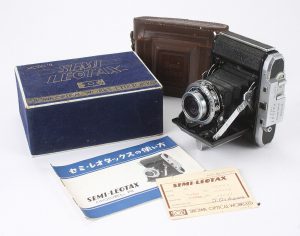
Nakagawa was very fond of folding German cameras and sought to build his own model which he wanted to call the Letax, a combination of the names of two of his favorite 35mm rangefinders, the Ernst Leitz Leica and Zeiss-Ikon Nettax. Because of trademark issues with the name Letax, the name Leotax was settled upon.
The first Leotax cameras were folding “Semi” models that shot 4.5cm x 6cm images on standard 120 roll film. This style of camera was very popular and also easy to make. A short time later, the company would release a 35mm rangefinder Leotax that was hand built by Nakagawa in a small workshop with the exception of the rangefinder which was outsourced to Nihon Kosokki Kogyo, and the lens which was made by Fujita. Strangely, despite being funded by Minagawa, the cameras were sold by a different Japanese distributor as Minagawa’s contracts with existing camera makers prohibited them from selling a competing model.
In early 1939, Yasuo Minagawa would join the company and take over production of the remaining cameras. It is believed that somewhere between 50 and 100 of these original Leotax cameras were produced at this time. In either late 1939 or early 1940, Nakagawa Kenzō would go off to war and some time later that year, a Mr. Eiji Suzuki would join the company and take over production.
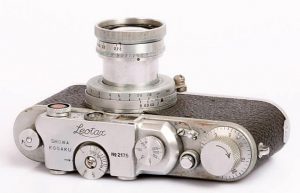
The original Leotax built by Nakagawa and Minagawa was a simpler version of the Leica II, with the biggest difference being that it had an uncoupled rangefinder, instead of a coupled one like both the Leica and Nippon cameras had. These cameras are easily spotted by the rangefinder distance wheel on the top plate of the camera where an accessory shoe would be on the Leica.
Most sites on the internet refer to a single original Leotax model that looks like the camera to the left. These cameras however, came later, being produced during the time when Eiji Suzuki was working for the company.
The true original Leotax has a very different rangefinder design, in which the focusing wheel is off to the right, immediately next to the shutter speed dial. Another difference is that the front of the camera has only two windows, suggesting that one had to be a combined viewfinder and rangefinder window, which if true, would have been a pretty advanced feature for the time.
According to Koichi Sugiyama’s book, “The Collector’s Guide to Japanese Cameras”, no known examples of this original Leotax are known to exist. The only image of one comes from a very small and low resolution image appearing on page 47 of Sugiyama’s book, which itself was taken from a 1939 photograph of the camera.
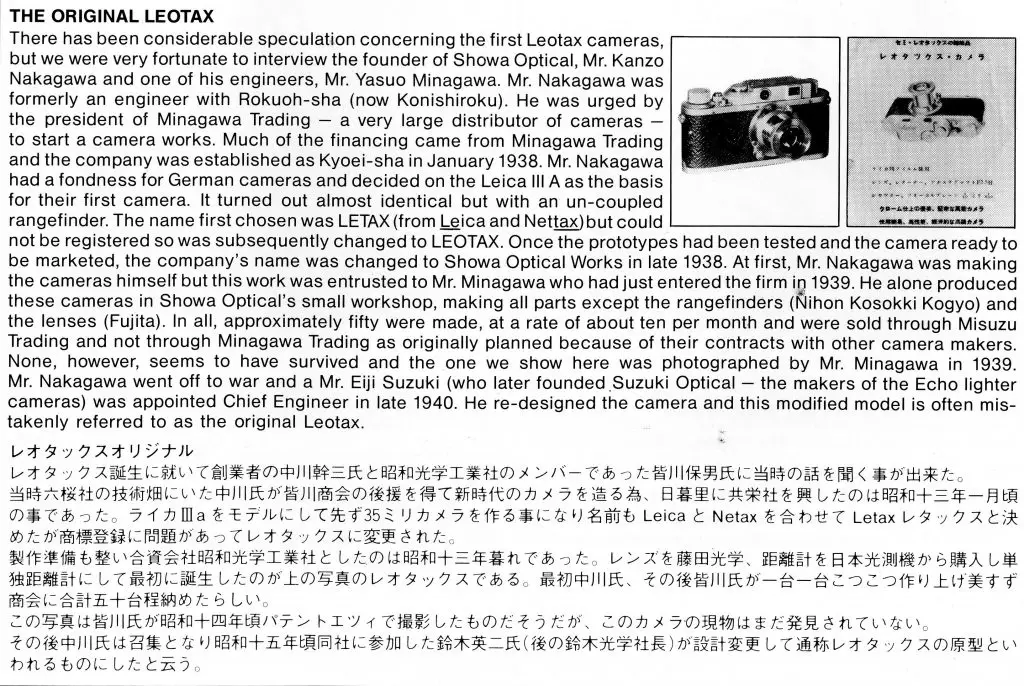
In the scan above, the two images of the original Leotax clearly show a different location for the uncoupled focus wheel, and the front of the camera has two, rather than three windows.
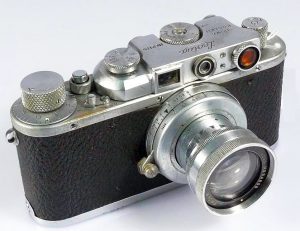
The cameras produced starting in 1940 were revised by Eiji Suzuki and have the uncoupled focus wheel in the center of the raised portion of the top plate, and three windows up front, one for the main viewfinder and two for the rangefinder. Most likely this change was done to simplify the design, as separating the viewfinder and rangefinder would have been a lot easier than trying to combine them together.
A negative side effect of this revised design is that from the images, the two rangefinder windows are very close together making for a very short rangefinder base length. In order to improve focus accuracy, the rangefinder windows were most likely heavily magnified, although I have found no evidence of this.
By 1942, Leotax had changed the rangefinder design and released two models, called the Leotax Special A and B, and started producing them for the Japanese military. Both new models had a more traditional coupled rangefinder, although still with a shorter base than those found in Nicca and original Leicas. The main difference between the two were that the Special A lacked slow speeds, and the Special B had a front mounted slow speed dial with speeds down to 1 second, like the Leica III. Production estimates of both the Leotax Specials A and B are around 250 examples, almost all of which went to the Japanese military.
After the war, the company would change names to Shōwa Kōgaku Seiki K.K. and would produce a civilian Leotax model, this time simply called the Leotax Special. This post war camera had identical specs to the wartime Leotax Special A and likely was built from spare parts from that model. Post-war Leotax Specials are easily identified from wartime ones as they lack strap lugs on the side.
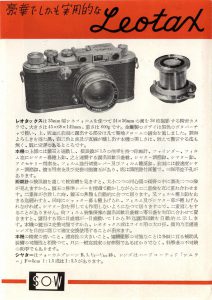
Over the course of the next several years, several new Leotax models would be released all with very similar features, the most significant of which was the Leotax Model D, which had an exact copy of the Leica’s rangefinder with 39mm base length. Cosmetically, the Leotax was now indistinguishable from the Nicca, apart from the logo. For more information about the various iterations of Leotax cameras of this era, check out the Corso Polaris Leotax page.
In 1954, Shōwa Kōgaku would release their first significant update to the Leotax line as the Leotax Model F. This new camera would have many updates that finally put it on a level playing field both in terms of features, but also quality of it’s Japanese and German competition.
Internally, the camera would have an all new, and much stronger die cast body that increased rigidity and strength around the lens mount. The top plate was slightly taller, and the three viewfinder and rangefinder windows would be revised to match those of the Leica IIIf. The shutter was improved, increasing it’s reliability, but also adding in a top 1/1000 speed, a first for a Leotax camera. Flash synchronization both for bulbs and electronic flashes was now standard, featuring a toggle switch in the shape of a self timer on the front of the camera, and a coaxial flash connector on the back. Other changes include a lock for the slow speed dial on the front, a film reminder dial on top of the wind knob, and an all new Topcor 50mm f/2 lens as standard.
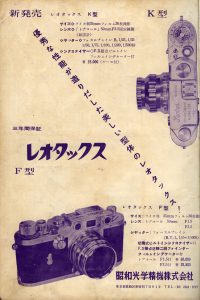
The Leotax Model F was the top of the line model in the Leotax family, but shortly after it’s release, two additional and lower cost models called the Model T and Model K would make their debut, with the only changes being the lack of the top 1/1000 shutter speed on both models, and a lack of slow speeds only on the Model K. Both cameras were offered with a lower cost f/3.5 standard lens, but could be upgraded to something better if desired.
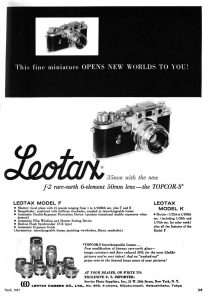
All three of these new models, the F, T, and K first went on sale with an engraving on the top plate with the company name “Showa Optical Works, Ltd.” but would change to “Leotax Camera Co., LTD.” around 1957.
Being the cheapest model, the Leotax Model K sold the best, with between 4000 and 5000 units produced. In the ad to the left from April 1957, we see both the Models F and K being sold by a New York importer, but no prices are listed.
A separate ad for Ritz Camera lists the price of the Model F with an f/2 Topcor lens for $159.95, so it’s not a stretch to guess that the cheaper Model K, with the slower f/3.5 lens probably sold for around $100.
The Leotax Model K would be produced until 1958 at which time it was replaced with the Model K3 which added a slow speed dial with speeds down to 1/8, changed the order of the speeds to the modern scale, and also upgraded the standard lens to a Fujinon f/2.8.
Leotax cameras would receive incremental updates for the next few years, adding combinations of things like a self-timer and a film advance lever on various models while not straying far from the formula they had been using for the past decade and a half.
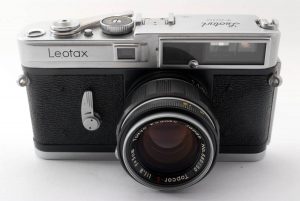
In 1961, a heavily redesigned Leotax model called the Leotax G was released. The new camera was still an interchangeable lens 35mm rangefinder that used the Leica Screw Mount but otherwise was significantly different from any other Leotax camera prior to it. Features of the Leotax G were:
- All new body and top plate design with a wider rangefinder base.
- Twin viewfinders in the style of the Nikon SP
- The primary finder had parallax corrected frame lines for 50mm and 90mm lenses
- The secondary finder showed fixed frame lines for 35mm and no rangefinder patch
- Redesigned shutter speed dial with all speeds from 1 – 1/1000 plus B and T on a non-rotating dial
- Automatic resetting exposure counter
- Combined shutter release and film advance lever
- Right hinged film compartment with separate bottom hinge to maintain compatibility with metal Leica style cassettes
- All new standard Topcor-S 5cm f/1.8 lens
- Later models have a shutter speed dial with notches on the edges, suggesting possible development of a coupled clip on exposure meter
From the list of features, it’s pretty clear that a lot of effort went into the creation of the Leotax G, but sadly it was a case of too little too late as Leotax would go bankrupt during it’s development. A high development cost and decline in demand for premium rangefinder cameras was too much for the small company to go on.
Around 500 Leotax G cameras were produced, but Leotax went out of business before finishing them all, so the remaining parts were finished by a third party company and sold through a Japanese distributor called Rokuwa.
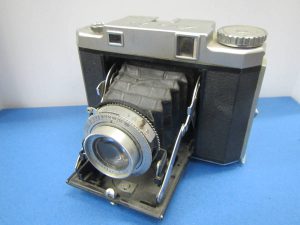
Leotax would never see the level of success of other A-list Japanese camera makers like Nikon, Canon, Minolta, or Olympus, but their products were generally well regarded. During my research for this article, I found it interesting that it’s founder, Nakagawa Kenzō did not return to the company he created as in 1953, he formed Aram Optical Institute, and rather than compete with his former company with a new 35mm rangefinder, created a camera called the Aram Six that shot 6cm x 6cm images on 120 roll film.
The Aram Six was a high quality camera, featuring a coupled rangefinder, Konitor 75mm f/3.5 lens set in a Konirapid-S leaf shutter, helical focusing, and a clever feature in which folding the camera shut automatically reset the focus distance to infinity to prevent it from hitting the door as it was closing. The Aram Six won an award for quality and design, but struggled with distribution delaying it’s release by three years, at which time, demand for an all new 6×6 folding camera was practically non-existent, and the camera sold poorly. It is estimated that only 100 of these cameras were produced.
Today, Leotax cameras are generally regarded as good, but not the best of all Japanese Leica copies. Most Leotax models fly under the radar as prices for them are usually quite low, but that only means they’re an incredible value for someone looking to get into Leica Thread Mount cameras for not a lot of money. If you have an opportunity to pick up one, there’s no reason not to, as despite their discount reputation, are still very capable and fun to use cameras.
My Thoughts
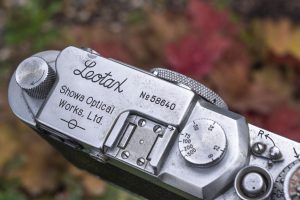
I was never on the lookout for a Leotax camera as I felt my Canon and Nicca LTM cameras did as good of a job as any to represent what a Japanese screw mount rangefinder would be like, but a deal’s a deal and when I saw this very rough looking Leotax K with a Buy it Now price of $30, I figured what the heck.
I had this idea of doing some kind of “Ugly Duckling” post in which I share some of the worst condition cameras I’ve ever had. I figured with Leotax’s history along with the look of the camera, it might make for an interesting article. Even if I never got around to writing about it, perhaps I could take it apart and get some practice on disassembling a Leica-style camera without risking a more valuable example.
But then it arrived, and to my complete amazement, this very sad looking camera worked perfectly! The shutter seemed accurate at all speeds, the viewfinder was a bit dirty, but the rangefinder patch was still easy to see, and more importantly, was accurate at infinity, and although the body was very heavily worn with bluish-green corrosion all over the place, it had no major damage to it. Looking at the front of the shutter curtains revealed no obvious damage, but since this is a bottom loader, I wouldn’t know for sure if it had any pinholes until I shot a roll of film through it.
My usual process any time I get a new camera is to wipe away any excess grime or dust and get it into a usable condition without making any effort to “restore” it as I think that patina and other cosmetic imperfections add to the mystique of an old camera. This Leotax had bluish-green corrosion in many locations which is likely a result of moisture damage to the brass underneath, but it wasn’t affecting the camera’s operation, and I kind of liked the way it looked, so I left it alone.
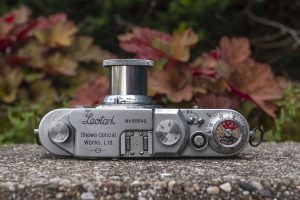
Unlike other Japanese companies like Canon or Minolta, Leotax didn’t stray too far from the formula of the original Leica II and III that their cameras were a copy of, so if you’ve ever used a screw mount Leica before, the control layout is nearly identical.

From left to right, there is a rewind knob, raised top plate with the logo and serial number on it, accessory shoe, rotating shutter speed dial with speeds from 1/25 to 1/500 plus B, film advance and rewind lever, shutter release button, and the combined film advance knob/exposure counter/film reminder dial. You must cock the shutter before changing speeds or else the indicated number will not line up with the small arrow on the accessory shoe.
Like all cameras with one-piece rotating shutter speed dials, you must make sure not to accidentally touch it while firing the shutter as doing so can throw off the shutter. The shutter release is not internally threaded for a shutter release cable, and although it does have a collar which looks like the kind that screw off to reveal external threads, I could not get it off, so either it’s not removable, or it’s just on so tight that I couldn’t get it.
Looking at the top plate and all of the controls, the quality is top notch, and cosmetically much better than that of Soviet Leica copies like the FED and Zorki rangefinders that fake Leicas are often made of. If someone was so inclined, turning a Leotax into a counterfeit Leica would result in a camera that’s much harder to spot as there are none of the obvious indicators.
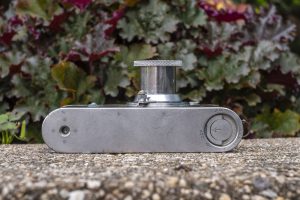
The bottom of the camera is plain, with only the 1/4″ tripod socket on one side and the familiar Open and Close key for accessing the film compartment.
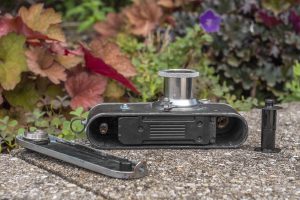
All Leotax rangefinders, with the exception of the Leotax model G are bottom loaders and load exactly the same as other Leica inspired bottom loading cameras.
There are many tutorials and videos online explaining this process and for the first time user, seems intimidating, but I promise you, it is something that you get used to quickly.
Rather than explain it here, I’ve linked to a good YouTube video showing the process. The only thing I would have done different from the video is after inserting the film into the camera, I like to advance it one full frame with the bottom still off so that I can see the film transporting out of the cassette onto the spool. If you do that, then you don’t need to take the lens off and look for the film through the shutter like he shows, but otherwise it is a good video.
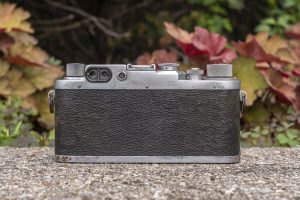
The back of the Leotax doesn’t have much to show other than the two windows for the viewfinder and rangefinder, plus the coaxial flash port. From the back, you can see a small detail that is often overlooked on screw mount Leicas and their copies, which is that the surface of the top plate and all the knobs are flat, meaning you can safely set the camera upside down on a flat surface, which makes loading film into the camera easier.
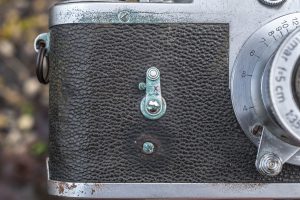
Up front, a small lever which looks like a self-timer is actually the flash sync switch for selecting between flashbulbs and electronic flashes. The X-sync speed is 1/25 seconds. Later Leotax cameras, usually those with the letter “V” in their name have self-timers, but this one does not.
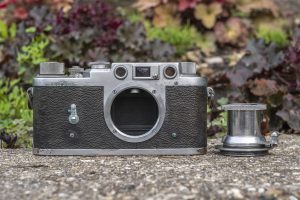
Up front, the Leotax has a standard 39mm screw lens mount which means that swapping lenses is just a twist of the wrist. Most Leotax Model Ks came with a rigid body 50mm f/3.5 Topcor as the standard lens, and since I didn’t have that lens, for this review I mounted a postwar Leitz Elmar 5cm f/3.5 as it most closely matched the optics of the standard lens. But no matter what lens you attach, the Leotax is fully compatible with any Nikkor, Zeiss, Soviet, or Japanese M39 rangefinder lens you have.
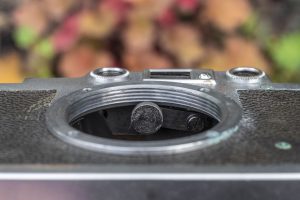
Before re-attaching the lens, another small detail of the camera which could have easily been a way for Leotax to cut some corners is in the rangefinder coupling wheel that closely matches the one found on genuine Leicas. Although all Japanese Leica copies have a wheel like this, Soviet copies do not, instead relying on a rigid arm that doesn’t always couple properly with every lens.
The Leotax K has separate windows for the rangefinder on the left and the main viewfinder on the right. The rangefinder has a magnification ratio of 1.5x which means that instead of seeing a normal 50mm image through the main viewfinder, what you see is like if you were looking through a 75mm lens. This has the benefit of making the circular rangefinder patch larger and easier to see. With combined coincident image rangefinders where the rangefinder is in the middle of the main viewfinder image, the rangefinder patch cannot be different from the main viewfinder, resulting in relatively small patches on most cameras. In the composite image below, you can see the magnification of the rangefinder window on the left.
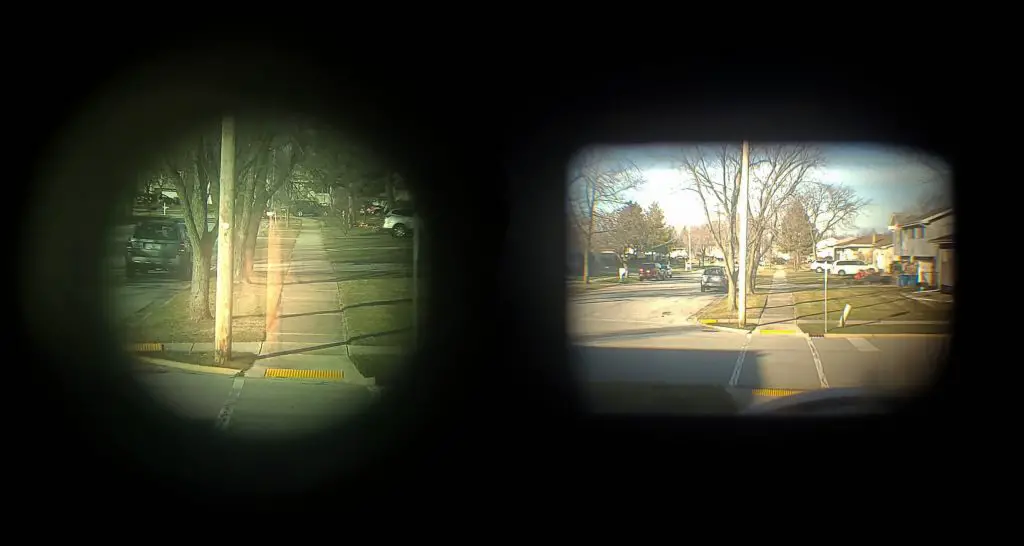
In the Leotax, the rangefinder circle takes up almost the entire view through the left rangefinder window, allowing you to see the split image much easier. As a wearer of prescription glasses, this is actually a huge benefit over the squinty circles found on other cameras. For me, having to move my eye back and forth between a rangefinder and viewfinder window is a minor issue, and is greatly offset by the benefit of very easy focusing.
If you’ve used any screw mount Leica or screw mount Leica copy, using the Leotax K doesn’t significantly change the experience. The greatest benefit of this camera was that when it was new, it offered a more economical way to get into interchangeable lens 35mm rangefinders. The user experience and build quality was good enough to where most owners of Leotaxes likely never upgraded to a Leica, yet the lenses were completely compatible. Even in today’s used market, cameras like the Leotax K sell for much cheaper than the real thing, maintaining that value proposition well over half a century later.
My Results
I picked up this camera without a lens in very poor condition for not a lot of money. I didn’t expect it to work, and had this idea of doing some kind of “Ugly Ducking” article with it. Upon getting it in the mail and seeing that despite it’s very ugly condition, it seemed to work OK, so I attached a spare Elmar f/3.5 lens and loaded in some expired Kodak Gold 200. I have a bunch of expired color film like this and usually save it for cameras which I don’t have high hopes for.














Before I comment on these images, I should address the elephant in the room, which is that I used a collapsible Leitz Elmar 50mm f/3.5 lens on this camera instead of something it likely would have had when it was originally sold. I did this as I simply did not have the correct lens and I thought this was a better option than a Soviet Industar or a faster Nikkor or Canon lens.
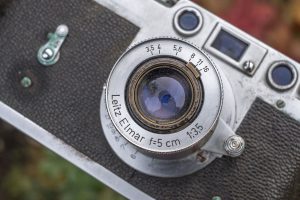
The Elmar’s 639xxx serial number dates it to 1947 which is a good eight years before the Leotax K was built, but with it’s 4-element design and coated optics, I do not think that it is that much of a stretch to compare it to the 5cm f/3.5 Topcor that many were sold with. Plus, according to Paul Sokk’s site on the Leotax, he suggests that some of the f/3.5 Topcors were an Elmar based design to begin with, so optically, the results should be quite similar.
It’s no secret that the Leitz Elmar punches above it’s weight, and these results do nothing to dispute that belief. I was impressed with the overall rendering of the images. Sharpness was excellent in the center, with only the slightest hint of softness near the corners. Vignetting was non-existent which is impressive as I had images of the sky in many of these shots. The postwar lens coating helped make the colors vibrant, although there is a bit of a color shift from the expired Kodak Gold I was using. From what I can see here, I see no reason to think that the Elmar wouldn’t have produced faithful colors on fresh film.
Of course this is a Leotax review and not an Elmar review, so I’ll start off by saying how impressed I was that this extremely rough looking camera worked perfectly. In case you skipped to this section and didn’t read my intro above, I picked up this Leotax body as a sort of “mercy” purchase due to it’s incredibly low $30 Buy It Now price. The camera was extremely dirty and covered in corrosion, so I bought it with no expectation that the camera would work, thinking maybe I could get some repair practice by taking it apart and seeing how it worked.
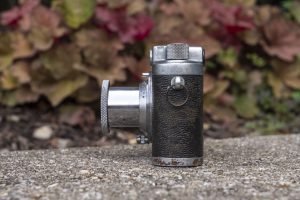
The camera’s rough condition suggests a pretty hard life with quite a bit of use, but whoever had this camera before me, likely took care of it as despite it’s cosmetics, was functionally perfect. The viewfinder was clear, the rangefinder was accurate, and the shutter was in good shape with no tears or obvious pinholes. I’ve seen many much nicer looking cameras with bad shutters or other functional problems, so while I would give this camera a D- for cosmetics, it’s a solid A in terms of operation.
Having used a variety of genuine Leicas, along with many Japanese and Soviet copies, I can say that despite the Leotax K being marketed as an entry level model, it faithfully recreates the experience of a genuine Leica. Since it lacks slow speeds, it would most closely resemble a Leica IIc, but with the FX flash sync lever. For someone 60 years ago in the market for an interchangeable lens rangefinder, the Leotax K would have been an incredible value, a declaration that I feel is still valid today. With sold prices in the range of $200 – $250 today for the IIc and around $100 for the Leotax K, this continues to be an excellent way to get into screw mount rangefinders without investing a lot into the body.
Now that I know this “ugly duckling” works great, I feel completely justified throwing it in a backpack on a hiking trip or letting it sit in my car’s center console without worry of damaging a precious luxury item. This Leotax K will continue to serve it’s intended purpose much more often than a mint shelf queen ever would. If you have a chance to pick one up yourself, give it a shot! I can’t guarantee that you’ll have the same luck as I in terms of perfect operation, but the risk is low, and if it does work, you’re really not missing much from a more expensive camera!
Related Posts You Might Enjoy
External Links
http://camera-wiki.org/wiki/Sh%C5%8Dwa_K%C5%8Dgaku
http://www.yashicatlr.com/Leotax.html#leotaxk
https://www.canonrangefinder.org/Leotax_Cameras.htm

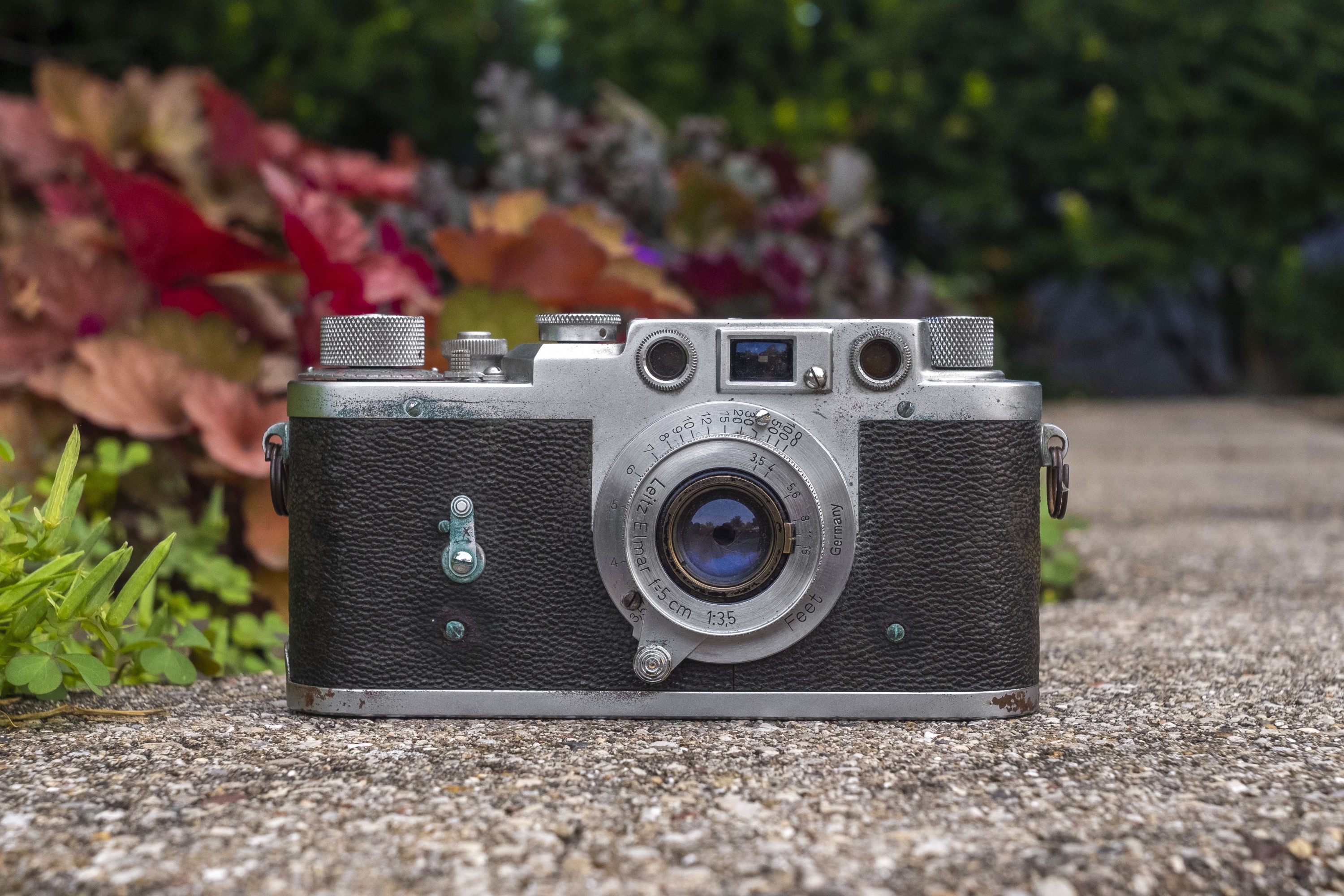


In the 1980’s, I did the equivalent of press photgraphy for an ad-supported community newspaper. By this time, Ye Olde Nikkormat had been put aside for a Nikon FM and I played around with Vivitar 283 or an Ascorlight electronic flash. The community hospital administrator was a World War II veteran who’d been in occupied Japan afterwards. We’d talk about cameras, and he’d mention his Leotax from time to time. I never got to see what model he had, but from his description, it was a match for the Family Leica IIIa. As a follower od Modern Photography’s “The Camera Collector” column written by Jason Schneider, I learned a thing or two about Japanese Leica copies.
What was more interesting back then was Shutterbug Ads, a newsprint, nationwide photographic want ad publication. Photos of the equipment for sale were rare, so you had to be be knowledgeable about old cameras. Niccas, Leotaxes, Canons, Leicas, Minoltas, etc. were listed according to Shutterbug Ads standards, from Mint to Good. In those early-Internet days, information was thin on ground, so books like Kalton C. Lahue’s “Glass, Brass, and Chrome’ or James Lager’s Leica books were non-real-time references. Great times for risk takers with more curiosity than money.;)
You got a terrific bargain on the Leotax. A quick look at Ebay shows one Model K at $149 and another at $386; neither with a lens!
It doesn’t happen as often as it used to, as I think used camera prices have been rising closer to what these things should be worth, but when you see a $30 LTM rangefinder, no matter the condition, you buy it! I remember when I scored it, thinking I was lucky, even though it looked terrible.
Mike, I had a Leotax Elite for a while; its chief attraction was its rapid lever film advance. Otherwise, it resembled your camera.
My Tower 45 has the film advance lever too, and while on paper it sounds like a useful feature, I do not find it any easier to use than knob wind. I think on some cameras a film advance lever is a good thing to have, but on screw mount rangefinders, it’s really not a necessary feature.
Mike, I tend to agree. “Modernising” a Barnack style Leica with a lever wind goes against the ethic of the camera and detracts from the charm of these cameras, be it a Barnack original or a copy.
I acquired my first Barnack, a IIIf with f1.5 Summarit, back in the latter years of the 1970’s. Over the last few years I set out to form a small collection of Barnack copies, but only one example per manufacturer and with a matched lens appropriate to the period. So far, I’ve accumulated a Fed 1-G, Zorki 1-C, Nicca 3-s and a Leotax TV2 Merite.
The Leotax turned out to be not what I was expecting. I realised it featured a lever wind, but whereas the others virtually followed the Barnack template, the Leotax is a Barnack on steroids! Whilst it retains the front-back body dimension, it is both taller and broader by several millivelimetres and which in the hand delivers a completely different handling experience and it doesn’t feel just quite right.